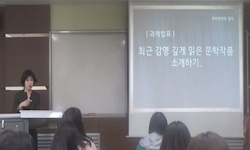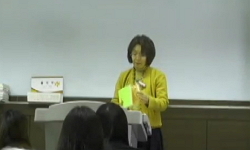The purpose of this research is to examine the relationship between intertextuality and metafictive devices of children's picture books. For this purpose the three major research questions are selected as follows. Question 1. What is the feature of t...
http://chineseinput.net/에서 pinyin(병음)방식으로 중국어를 변환할 수 있습니다.
변환된 중국어를 복사하여 사용하시면 됩니다.
- 中文 을 입력하시려면 zhongwen을 입력하시고 space를누르시면됩니다.
- 北京 을 입력하시려면 beijing을 입력하시고 space를 누르시면 됩니다.
그림책의 상호텍스트성 연구 : 메타픽션 기법을 중심으로 = A Study on Intertextuality in Picture Books : Focusing on Metafictive Devices
한글로보기https://www.riss.kr/link?id=A76523838
- 저자
- 발행기관
- 학술지명
- 권호사항
-
발행연도
2008
-
작성언어
Korean
- 주제어
-
KDC
375.1
-
자료형태
학술저널
-
수록면
51-74(24쪽)
- 제공처
- 소장기관
-
0
상세조회 -
0
다운로드
부가정보
다국어 초록 (Multilingual Abstract)
Question 1. What is the feature of the intertextuality in children's picture books?
Question 2. What is the feature of the metafictive devices in children's picture books?
Question 3. How is the intertextuality represented through the metafictive devices in children's picture books?
To prove those subjects, I analyzed the way metafictive devices are presented in the intertextuality, covering 4 selected picture books. All of the subjects 1, 2, 3, are composed of literature researches. The mtertextuality of the selected picture books was analyzed in the context of transtextuality, which was presented in the study by Harris and Mckenzie(2005). The metafictive devices was analyzed on the basis of 17 metafictive devices from the study of Panta1eo(2005). In the picture books, metafictive devices were actually used, so I focused on how the intertextuality is presented.
The summery of the research result is as following;
First, the intertextuality in children's picture books is represented as a form of familiar characters in film, TV soap opera, or fairy tales. Other factors around text, such as book covers, book wings and end papers were used as cues for the authors to take note. Those surroundings provided a clue to understand the story.
Second, the metafictive devices were presented as peculiar features of stories and illustrations because the technique bridges each text and induces active participation from readers. The metafictive device in the picture book shows more than two narratives are connected and conclude as one story. Differently sized, colored letters and typograpic methods were used as a way to exhibit metafiction.
Third, the result of study to examine how the intertextuality was presented shows that pastiche or parody methods were used in characters, narratives, and background settings. This is due to the communication method of a picture book. The intertextuality was exhibited sometimes in inner scenes of the books or sometimes in quotations from other genres or other authors' books, In particular, certain characters from well-known fairy tales showed more intertextuality.
The purpose of this research is to examine the relationship between intertextuality and metafictive devices of children's picture books. For this purpose the three major research questions are selected as follows.
Question 1. What is the feature of the intertextuality in children's picture books?
Question 2. What is the feature of the metafictive devices in children's picture books?
Question 3. How is the intertextuality represented through the metafictive devices in children's picture books?
To prove those subjects, I analyzed the way metafictive devices are presented in the intertextuality, covering 4 selected picture books. All of the subjects 1, 2, 3, are composed of literature researches. The mtertextuality of the selected picture books was analyzed in the context of transtextuality, which was presented in the study by Harris and Mckenzie(2005). The metafictive devices was analyzed on the basis of 17 metafictive devices from the study of Panta1eo(2005). In the picture books, metafictive devices were actually used, so I focused on how the intertextuality is presented.
The summery of the research result is as following;
First, the intertextuality in children's picture books is represented as a form of familiar characters in film, TV soap opera, or fairy tales. Other factors around text, such as book covers, book wings and end papers were used as cues for the authors to take note. Those surroundings provided a clue to understand the story.
Second, the metafictive devices were presented as peculiar features of stories and illustrations because the technique bridges each text and induces active participation from readers. The metafictive device in the picture book shows more than two narratives are connected and conclude as one story. Differently sized, colored letters and typograpic methods were used as a way to exhibit metafiction.
Third, the result of study to examine how the intertextuality was presented shows that pastiche or parody methods were used in characters, narratives, and background settings. This is due to the communication method of a picture book. The intertextuality was exhibited sometimes in inner scenes of the books or sometimes in quotations from other genres or other authors' books, In particular, certain characters from well-known fairy tales showed more intertextuality.
목차 (Table of Contents)
- Ⅰ. 서론
- 1. 연구의 필요성 및 목적
- Ⅱ, 연구방법
- 1. 분석대상
- 2. 분석 준거 및 방법
- Ⅰ. 서론
- 1. 연구의 필요성 및 목적
- Ⅱ, 연구방법
- 1. 분석대상
- 2. 분석 준거 및 방법
- Ⅲ. 연구결과
- 1. 그림책에 나타난 상호텍스트성
- 2. 그림책에 나타난 메타픽션 기법
- 3. 그림책 상호텍스트성과 메타픽션기법과의 관련성
- Ⅳ. 요약 및 논의
- 참고문헌
- Abstract
동일학술지(권/호) 다른 논문
-
공립유치원 고경력 교사가 인식한 교직갈등의 요인 및 갈등정도
- 부산대학교 보육종합센터 영유아보육연구소
- 류해경
- 2008
-
- 부산대학교 보육종합센터 영유아보육연구소
- 정희남
- 2008
-
유아의 형제관계에 따른 사회·인지적 놀이형태와 또래놀이 상호작용에 관한 연구
- 부산대학교 보육종합센터 영유아보육연구소
- 변현영
- 2008
-
- 부산대학교 보육종합센터 영유아보육연구소
- 오정희
- 2008




 RISS
RISS







